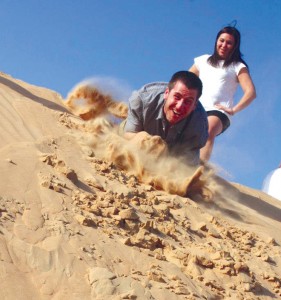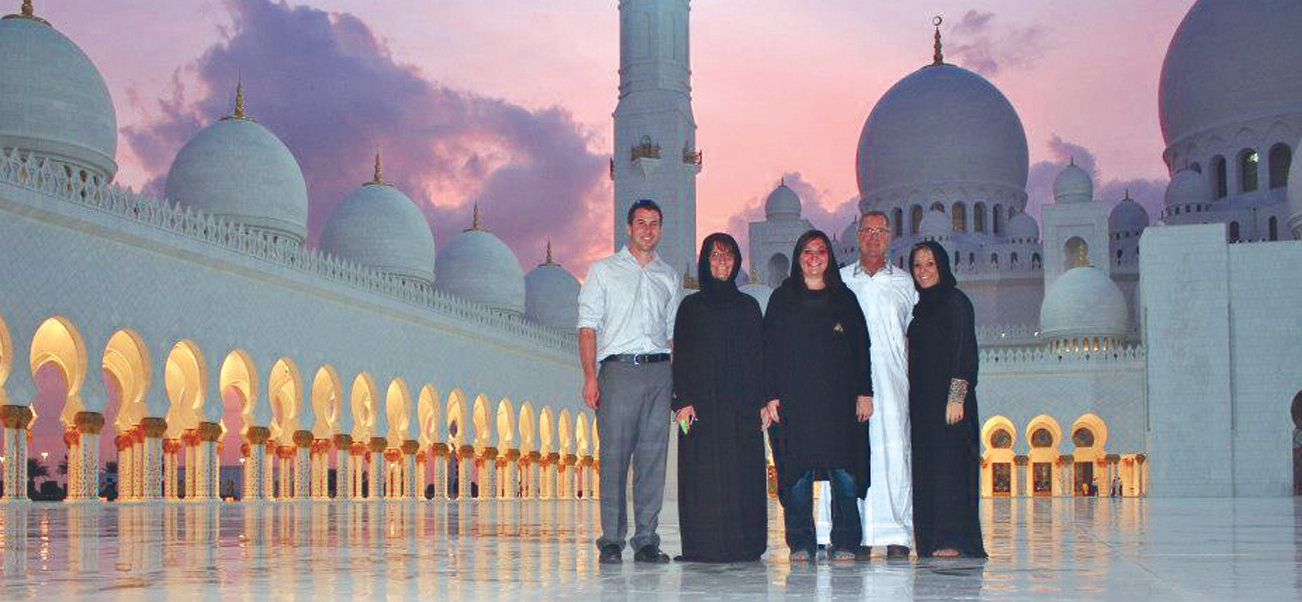Four family members from the Roslyn-Eden area who visited Abu Dhabi recently say the trip was interesting and an eye-opener.
Josh Wagner, Art Steiner, Karli and Lori Opitz flew to the UAE Nov. 28 and returned home Dec. 8. Their main purpose was to visit Lori’s daughter and Karli’s sister, Andrea, who is in her second year of teaching elementary school. Art is Andrea’s uncle and Josh is a cousin.
The group flew to Chicago and from there jetted to Frankfurt, Germany, before finally disembarking in Abu Dhabi 27 hours later. The day the foursome arrived was a national holiday celebrating the country’s independence.
[one_third]
A fast rise for desert nation
Up until after World War II, the United Arab Emirates was sustained by camel herding, production of dates and vegetables at the inland oases and pearl diving. Oil was first found in 1958 but had a marginal impact on the economy. In the 1960s the ruling Al Nahyan family decided to further develop the country with the assistance of the British. Sheikh Zayed became the new ruler and the driving force behind the formation of the UAE. After the Emirates gained independence in 1971, oil wealth continued to flow and traditional mud-brick huts were rapidly replaced with banks, boutiques and modern high rises.
Abu Dhabi is one of seven emirates that constitute the United Arab Emirates (UAE). It is the capital and is the largest emirate by area and second largest by population after Dubai. This wealthy emirate’s main revenues come from oil, industry, construction and financial services which make up a $187 billion economy. This emirate is also pushing hard to become a destination tourism location for Europe and the Middle East and is known for its fancy hotels and over-the-top shopping districts.
[/one_third]
To mark the national holiday the group went to the beach and enjoyed the local festivities, some of which were rather strange, like spraying each other with silly string and foam. They also decorated their cars in the national colors and enjoyed fireworks and an air show.
Wagner said the weather was nice the entire time they were there, although it did rain on three occasions, something the country hadn’t seen for the last two years. On their second day the group made the first of two visits to Dubai, the UAE’s largest city where they found themselves in a traffic jam because a heavy rain flooded the road.
Other high points on their numerous sight-seeing trips were visits to the Burj Khalifa, the tallest building in the world, touring the world’s largest shopping mall and paying visits to the Palm Islands and the Atlantis Hotel. On one of their out-of-the-way side tours, the group toured an oasis where they picked dates and visited a historical fort which was the home of the UAE founder Sheikh bin Zayed.
While there they also got a chance to see falcons flown and to ride camels. Some of the visitors had the option to stay overnight in a tent, but this group said it really wasn’t roughing it because the tents had beds and color televisions. They also went to a water park where they went white water rafting on the same trip.
Another high point was a visit to the Sheikh Zayed Grand Mosque, the largest mosque in the UAE and eighth largest in the world. The mosque site is equivalent to approximately five football fields. As the country’s grand mosque, it is the key place of worship for Friday gathering and Eid prayers and can hold more than 40,000 people. The mosque manages day-to-day operations, as a place of worship and Friday gatherings, but is also a center for learning through its educational cultural activities and visitor programs. The Sheikh Zayed Grand Mosque, which took 11 years to build, has many special and unique elements. Its carpet in the main prayer hall is considered to be the world’s largest carpet, measuring 60,570 square feet. It was made by 1,200-1,300 Iranian carpet knotters. The mosque has seven imported chandeliers from Germany that incorporate millions of Swarovski crystals. It is the second largest known chandelier inside a mosque, the third largest in the world, measuring 33 feet in diameter and 49 feet high. The pools along the arcades reflect the mosque’s spectacular columns, which are lit up at night. The unique lighting system reflects the phases of the moon. The 96 columns in the main prayer hall are clad with marble and inlaid with mother-of-pearl craftsmanship.
The four travelers say moving around the country wasn’t difficult. Almost everywhere they went someone spoke English and much of the country dresses like Westerners do, although there were places where the women had to wear burkas to cover their hair and face.
“The country seemed pretty modern,” Wagner noted. “There wasn’t any dress codes and the buildings were very modern and cosmopolitan.”
Interestingly Abu Dhabi’s population is 8 million, but of those, only 20 percent are native residents. The country imports many workers from Europe, the Philippines, Pakistan or Thailand.

The group said the food wasn’t too bad, noting there was no shortage of American fast food with almost every franchise available. They did take high tea at the Emirates Grand Palace Hotel where $100 got you several finger sandwiches and a couple of cups of tea. The going rate for a room in this seven-star hotel was $2,300 a night. They say most locals eat a lot of lamb, chicken and humus, but found their grocery stores not too much different from their American counterparts, although almost every item had a country of origin label on it.
One place they hoped to visit but couldn’t was Andrea’s school. From what they learned, the public schools segregate kids by gender, and the students spend half the day getting traditional subjects like English, science and math while the other half-day is devoted to Muslim teachings and language.
Overall, the foursome felt Abu Dhabi is a clean, safe and well-planned city.
Asked what their favorite experiences were, Art and Josh said the grand mosque, while Karli said probably the water park or the camel ride.
All four say the trip was worthwhile, although none of them said they plan to return anytime soon.

Leave a Reply